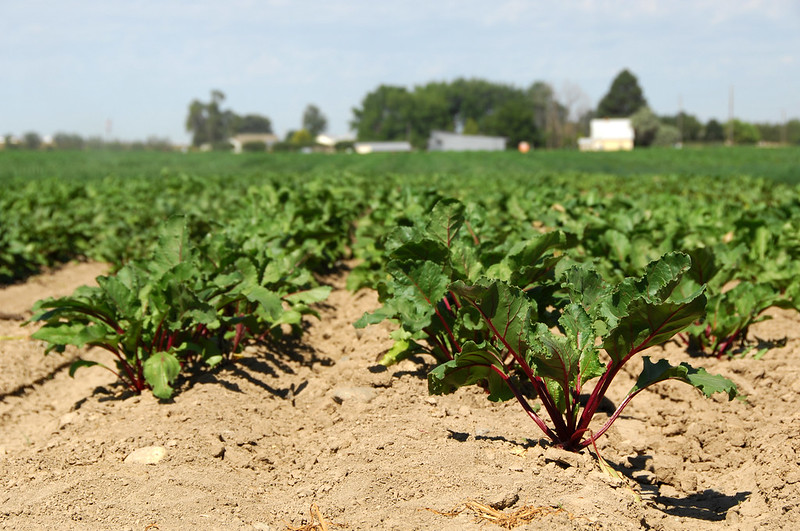Developing New Crop Varieties with Enhanced Traits and Disease Resistance
ARS scientists are developing new crop varieties, including specialty crops (e.g., vegetables, fruits, and nuts), by exploiting the underutilized genetic diversity contained in ARS crop genebanks, In FY 2021 plant releases included two improved carrot lines, two Pinto dry bean varieties (‘USDA Diamondback’ and ‘USDA Basin’), two pea varieties (‘USDA Dint Winter’ and ‘USDA Mica Winter’), the ‘Rainier Russet’ potato variety, two peach cultivars (‘May Joy’ and ‘Flavor Joy’) and varieties of many other crops. The following accomplishments are examples of ARS advances in crop breeding for resistance to diseases and pests, tolerance to environmental stresses, superior yield, and trait enhancement in 2021.
New grass and wildrye cultivars improve rangeland use and restoration. On western rangelands, native grasses are planted for livestock grazing, rangeland revegetation, wildlife habitat, and soil conservation. For many of these grasses, seed shattering makes it difficult for suppliers to harvest seed that is needed for these uses. Furthermore, many ranchers are using less productive private lands for pasture as an alternative to grazing public lands. These marginal areas are often dry, salty, low in soil nutrients, and receive little irrigation, all of which makes plant establishment and growth difficult. ARS researchers in Logan, Utah, developed ‘HighWest’, a new meadow bromegrass with improved seedling establishment, protein and energy, and forage growth. HighWest total forage production was 23 percent greater than other cultivars and had up to 6 percent more protein and 22 percent more energy; regrowth also doubled after cutting. All these improvements make it an excellent grass for grazing on marginal lands. ARS researchers also developed ‘L-74X’, a new basin wildrye that had up to 167 percent more harvestable seed and 20 percent improved seed germination. This new basin wildrye is now being used as a parent by plant breeders to develop commercial varieties of basin wildrye. These developments are providing critical tools needed for rangeland revegetation, conservation, and cattle production.
‘Yorizane’, a new self-fertile almond cultivar. Eighty percent of the world’s almonds are grown in California, and the majority of the 1.5 million acres are planted with cultivars that require bees to transfer pollen between different trees to produce nuts. Self-fertile varieties require fewer pollinators in the orchard because the pollen moves only a short distance within the flower or within the tree to produce nuts. The California almond industry wants new self-fertile cultivars to reduce the need for honeybees and pollinators. ARS researchers in Parlier, California, developed the new self-fertile ‘Yorizane’ cultivar, which yielded well in regional trials throughout the San Joaquin Valley for five commercial harvests. Yorizane nuts have been rated highly by the almond industry in marketing potential and kernel appearance and it has great potential for adoption by almond growers.
Modifying plant traits without modifying plant genes. Insect-vectored plant disease can be extremely difficult to control, especially in long-lived trees, because a single piercing-sucking insect can inject a dose of a disease pathogen. ARS researchers in Fort Pierce, Florida, in collaboration with ARS researchers in Ithaca, New York, and a small agribusiness in Florida, developed a novel Agrobacterium-based method of creating a host plant cell that can produce its own growth regulating molecules and can be grown as symbionts attached to crop plants. This method was first demonstrated in tomato and sunflower plants and results showed that symbionts engineered to produce Bacillus thuringiensis (Bt) toxins killed 100 percent of caterpillar larvae after 3 days of feeding on an artificial diet supplemented with engineered symbiont tissue. Insects with chewing mouthparts, such as caterpillars, were specifically chosen to prove that the symbiont produces a lethal amount of Bt toxin. The next steps of the study will be to test the engineered symbiont tissue on piercing-sucking insects, such as the Asian citrus psyllid, which is a vector of citrus greening disease. Implementing this pest-insect control strategy will enable a rapid response to emerging pest-insect threats and will more easily deliver therapeutic technologies to diverse germplasms. Researchers are also planning to test if engineered symbiont tissues can be used as a biofactory of harvestable biological insecticide molecules or therapeutics that could potentially create new cropping systems. Results of this study will show that symbiont technology has the potential to bring transformational advancements to plant disease management and the mass production of biomolecules.
Model predicts threat of zebra chip potato disease. In the U.S. Pacific Northwest, where most of the U.S. potato crop is grown, zebra chip has become a widespread and economically devastating potato disease. The zebra chip pathogen is a bacterium that is spread by the potato psyllid and proper pathogenic control can be accomplished only by controlling the insect vector. U.S. potato farmers have had difficulty controlling zebra chip because they lack the tools to estimate potato psyllids populations, which can fluctuate greatly from year to year. ARS scientists in Wapato, Washington, and Washington State University collaborators determined that the weed matrimony vine is an important host plant for potato psyllids in early spring. Matrimony vine was not found to be susceptible to the zebra chip pathogen, and is therefore not the source of infected psyllids, but ARS scientists found that psyllid numbers on matrimony vines in the spring can be used as an indicator of psyllid populations in potatoes in late August. This novel forecasting method for psyllid populations will allow growers to take action to protect their crops and associated revenues in years when psyllid outbreaks are expected.
 Strough, Kirsten. A field of red beets grow on Rick and Robyn Purdum's farm. Fruitland, Idaho. 2012. USDA Photo. https://flic.kr/p/2kLgkSS
Strough, Kirsten. A field of red beets grow on Rick and Robyn Purdum's farm. Fruitland, Idaho. 2012. USDA Photo. https://flic.kr/p/2kLgkSS

